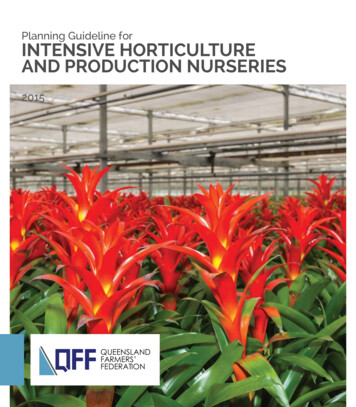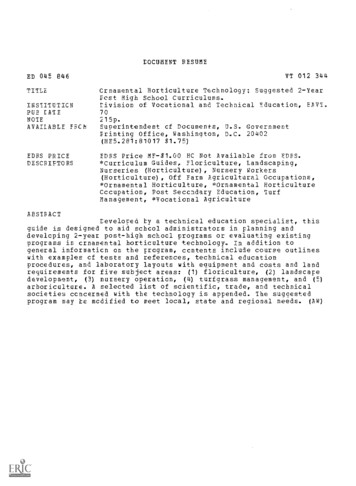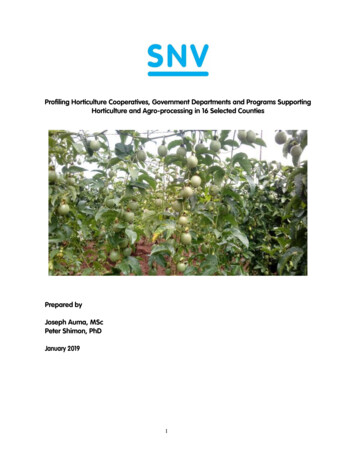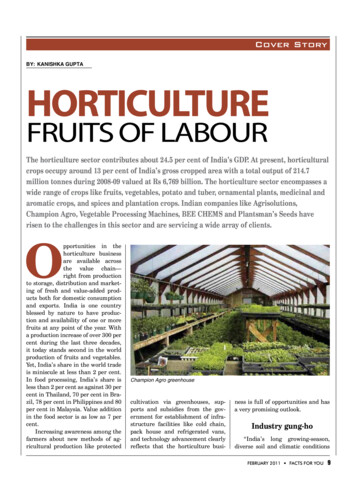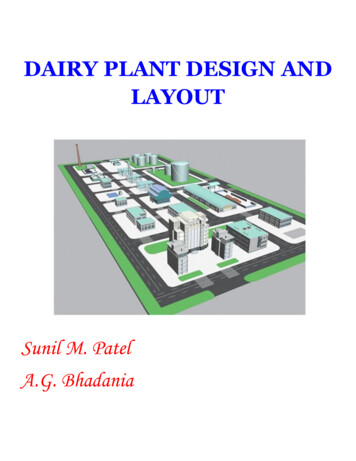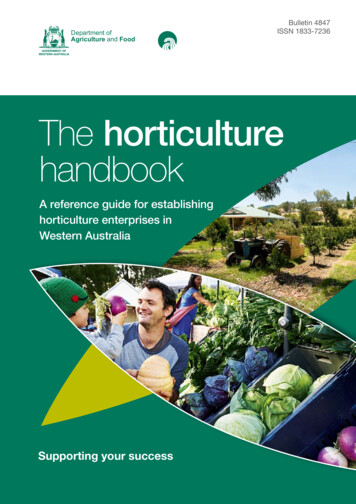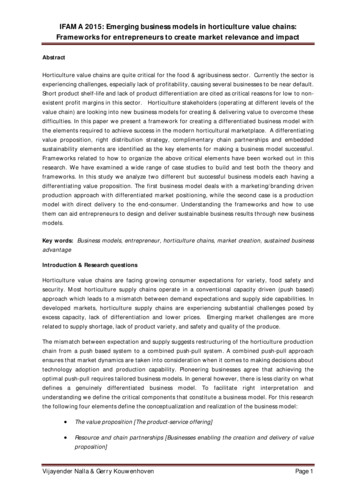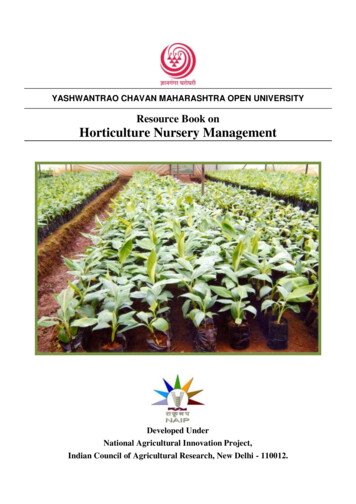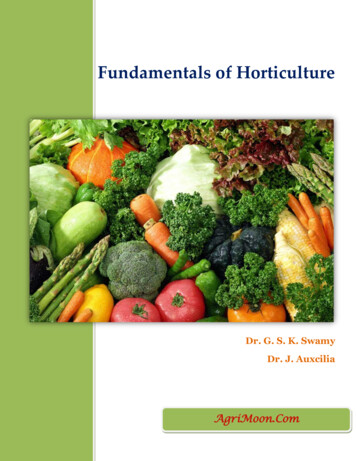
Transcription
Fundamentals of HorticultureDr. G. S. K. SwamyDr. J. AuxciliaAgriMoon.Com
Fundamentals of Horticulture-: Course content creator :-Dr. G. S. K. SwamyAssociate Professor (Fruit science)Kittur Rani Channamma College of Horticulture, Arabhavi-:Content moderater :-Dr. J. AuxciliaAssistant Professor (Fruit Crops)Horticulture College & Research Institute, TNAU, Coimbatore
IndexLectureLecture No.1Lecture No.2NamePage No4-78-10IntroductionHorticultural crops and Human NutritionLecture No.3Climatic Requirement11-15Lecture No.4Horticultural Zones of India16-17Lecture No.5Lecture No.6&7Lecture No.8 & 9Lecture No.10Soil RequirementImportance of Nursery and its managementPlanning of OrchardOrchard18-2021-2223-2526-30Lecture No.11Lecture No.12Lecture No.13&14Kitchen gardenDigging and filling of pitsOrchard Management31-3233-3536-46Lecture No. 15 & 16Lecture No. 17&18Water managementManures and manuring47-4950-54Lecture No. 19Lecture No.20,21,22&23Lecture No. 24 &25Weed management in OrchardTraining and pruning55-5859-6364-67Lecture No. 26Kinds of flower bearing shoots (can it be clubbed withpruning in last chapter?)Top WorkingLecture No. 27&28Lecture No. 29Problem of UnfruitfulnessOrganic farming69-7374-75Lecture No. 30,31&32Lecture No. 33, 34 &35Lecture No. 36Plant growth regulatorsMaturity indices for fruitsMarketing of fruits (can this be dropped?)76-8182-868768
Fundamentals of HorticultureLecture No.1INTRODUCTIONIndia is the seventh largest country in the world with a total geographical area of 328.73m ha. and has second largest population 121crores (2011), after China. The total arable landavailable is 144 million hectare of which 70% is under rainfed cultivation. Around 55-60 percent of the total population depends on agriculture and allied activities. Horticulture cropsconstitute a significant portion of total agricultural production in the country.The term Horticulture is derived from the Latin words: “hortus” meaning garden and“cultura” meaning cultivation. In ancient days the gardens had protected enclosures with highwalls or similar structures surrounding the houses. The enclosed places were used to grow fruit,vegetables, flowers and ornamental plants. Therefore, in original sense “Horticulture refers tocultivation of garden plants within protected enclosures”.At present the horticulture may be defined as the science and technique of production,processing and merchandizing of fruits, vegetables, flowers, spices, plantations, medicinal andaromatic plants.Branches of HorticultureHorticulture is a wide field and includes a great variety and diversity of crops. Thescience of horticulture can be divided into several branches depending upon the crops it dealswith. The following are the branches of horticulture.1. Pomology: refers to cultivation of fruit crops.2.Olericulture: refers to cultivation of vegetables.3. Floriculture: refers to cultivation of flower crops.4. Plantation crops: refers to cultivation of crops like coconut, arecanut, rubber, coffee,tea etc.5. Spices crops: refers to cultivation of crops like, cardamom, pepper, nutmeg etc.6. Medicinal and aromatic crops: deals with cultivation of medicinal and aromatic crops.7. Post harvest technology: deals with post harvest handling, grading, packaging,storage, processing, value addition, marketing etc. of horticulture crops.8. Plant propagation: deals with propagation of plants.Fruit crops: India is the second largest producer of fruits after Brazil. A large variety of fruitcrops are grown in India. Of these, mango, banana, citrus, papaya, guava, pineapple, sapota,jackfruit, litchi, grapes, apple, pear, peach, plum, walnut etc. are the important ones.AgriMoon.Com4
Fundamentals of HorticultureIndia accounts for 10 per cent of the total world production of fruits. It leads the world in theproduction of mango, banana, sapota and acid lime besides recording highest productivity ingrape. The leading fruit growing states are Maharashtra, Karnataka, Andhra Pradesh, Bihar andUttar Pradesh.Vegetable crops: More than 40 vegetables belonging to Solanaceaeous, cucurbitaceous,leguminous, cruciferous, root crops and leafy vegetables are grown in Indian tropical , subtropical and temperate regions. Important vegetables grown in India are onion, tomato, potato,brinjal, peas, beans, okra, chilli, cabbage, cauliflower, bottle gourd, cucumber, watermelon,carrot, radish etc.India ranks second in vegetable production next to China in area and productioncontributing 13.38 percent to the total world production. India occupies first position incauliflower, second in Onion, third in cabbage in the world. West Bengal, Orissa, Uttar Pradesh,Bihar, Maharashtra, Karnataka are the important states for horticultural crop production.Floriculture: Flower cultivation is being practiced in India since ages. It is an important/integralpart of socio-cultural and religious life of Indian people. It has taken a shape of industry in recentyears.India is known for growing traditional flowers such as jasmine, marigold,chrysanthemum, tuberose, crossandra, aster, etc. Commercial cultivation of cut flowers like,rose, orchids, gladiolus, carnation, anthurium, gerbera is also being done. The important flowergrowing states are Tamil Nadu, Karnataka, Andhra Pradesh, Maharashtra, West Bengal, Sikkim,Jammu &Kashmir, Meghalaya etc.Plantation crops: This is one of the important sector contributing about Rs.7500 crores ofexport earnings. The major plantation crops include coconut, arecanut, oil palm, cashew, teacoffee, rubber cocoa, betel vine, vanilla etc. The leading states are Karnataka, Kerala, TamilNadu, Andhra Pradesh, Maharashtra, Goa, Assam etc.Spices: They constitute an important group of horticulture crops and are defined as vegetableproducts or mixture thereof, free from extraneous matter used for flavouring, seasoning andimparting aroma in foods. India is known as home of spices producing a wide variety of spiceslike black pepper, cardamom, ginger, turmeric, chilli, Coriander etc. Major spice producingstates are Kerala, Andhra Pradesh, Gujarat, Rajasthan, Maharashtra, Karnataka, Orissa, TamilNadu etc.Medicinal and Aromatic plants: India has diverse collection of medicinal and aromatic plantsspecies distributed throughout the country. It has more than 9500 species with medicinalproperties. Demand for these crops is increasing progressively in both domestic and exportmarkets. Important medicinal plants are Isabgol, Senna, Opium poppy, Periwinkle, Coleus,Ashwagandha, etc. and aromatic plants are Japanese mint, Lemon grass, Citronella, Davana,Patchouli etc.AgriMoon.Com5
Fundamentals of HorticultureFeatures of Horticulture1. Horticultural produces are mostly utilized in the fresh state and are highly perishable.2. Horticultural crops need intensive cultivation requiring a large input of capital, labourand technology per unit area.3. Cultural operations like propagation, training, pruning and harvesting are skilled andspecific to horticultural crops.4. Horticultural produce are rich sources of vitamins and minerals and alkaloids.5. Aesthetic gratification is an exclusive phenomenon to horticultural science.Importance of HorticultureHorticulture is important for the following considerations:1. As a source of variability in produce.2. As a source of nutrients, vitamins, minerals, flavour, aroma, alkaloids, oleoresins, fibre,etc.3. As a source of medicine.4. As an economic proposition as they give higher returns per unit area in terms of energy,money, job, etc.5. Employment generation 860 man days/annum for fruit crops as against 143 mandays/annum for cereal crops and the crops like grapes, banana and pineapple need 10002500 man days per annum.6. Effective utilization of waste land through cultivation of hardy fruits and medicinalplants.7. As a substitute of family income being component of home garden.8. As a foreign exchange earner, has higher share compare to agriculture crops.9. As an input for industry being amenable to processing, especially fruit and vegetablepreservation industry.10. Aesthetic consideration and protection of environment.11. Religious significance.In short horticulture supplies quality food for health and mind, more calories per unit area,develops better resources and yields higher returns per unit area. It also enhances land value andcreates better purchasing power for those who are engaged in this industry. Therefore,horticulture is important for health, wealth, hygiene and happiness.Scope of HorticultureLike any other things, scope of horticulture depends on incentive it has for the farmers,adaptability of the crops, necessity and facilities for future growth through inputs availability andinfrastructure for the distribution of produce/marketing etc.AgriMoon.Com6
Fundamentals of HorticultureIncentive for the farmer: The biggest incentive for the farmer is money andhorticultural crops provide more returns in terms of per unit area production, export value, valueaddition compared to agricultural crops.Adaptability: India is bestowed with a great variety of climatic and edaphic conditions as wehave climates varying from tropical, subtropical, temperate and within these humid, semi-arid,arid, frost free temperate etc. Likewise we have soils like loam, alluvial, laterite, medium blackrocky shallow, heavy black, sandy etc. and thus a large number of crops can be accommodatedwith very high level of adaptability. Thus, there is good scope for horticultural crops.Necessity: After having achieved self sufficiency in food, nutritional security for the people ofthe country has become the point of consideration/priority. Moreover, Indians are basicallyvegetarians, and to meet their nutritional requirement in terms of vitamins and mineralshorticulture crops are to be grown in sufficient quantities to provide a bare minimum of 85 g offruits and 200 g of vegetables per head per day with a population of above 120 crores. Continuedincrease in demand for horticultural produce provides tremendous scope for the growth of thisindustry.Good land is under pressure for stable food, industry, housing, roads and infrastructuredue to population explosion and only wasteland had to be efficiently utilized where cultivation ofannuals is a gamble due to restricted root zone and their susceptibility of abiotic stress. Theselands can be best utilized to cultivate hardy horticultural crops like fruits and medicinal plants.At present our share in international trade of horticultural commodities is less than one percent of total trade. Moreover, these commodities (spices, coffee, tea) fetch 10-20 times moreforeign exchange per unit weight than cereals and therefore, taking advantage of globalization oftrade, nearness of big market and the size of production, our country should greatly involve ininternational trade which would provide scope for growth.In the recent past communication and transport system have improved, investment in foodindustry has increased which will support growth of horticulture through quick deliverance andavoidance of waste.In brief it can be stated that horticulture has great scope for the following reasons:1. To exploit great variability of agro climatic conditions.2. To meet the need for fruits, vegetables, flowers, spices, beverages in relation topopulation growth based on minimum nutritional and other needs.3. To meet the requirement of processing industry.4. To substitute import and increase export.5. To improve the economic conditions of the farmers and to engage more labourers toavert the problem of unemployment.6. To protect environment.AgriMoon.Com7
Fundamentals of HorticultureLecture No.2Horticultural crops and Human NutritionFruits and vegetables play an important role in balanced diet. These provide not onlyenergy rich food but also provide vital protective nutrients/elements and vitamins. Comparativelyfruits and vegetables are the cheapest source of natural nutritive foods. Since most of Indians arevegetarians, the incorporation of horticulture produce in daily diet is essential for good health.With the growing awareness and inclination towards vegetarianism worldwide the horticulturecrops are gaining tremendous importance.Functions of fruits and vegetables in human body:1. Fruits and vegetables provide palatability, taste, improves appetite and provides fibrethereby the constipation can be overcome.2. They neutralize the acids produced during digestion of proteins and fatty acids.3. They improve the general immunity of human body against diseases, deficiencies etc.4. They are the important source of vitamins and minerals for used in several bio-chemicalreactions occur in body.Fruits:Fruits provide higher energy value per unit area compared to cereals. Some of the essentialnutrients provided by different fruits are:Vitamins/MineralsRole in human bodySourceVitamin-A1. Essential for growth andreproduction.2. Helps in resistance to infections,increases longevity anddecreases senility.3. Deficiency causes, nightblindness, xeropthalmia,retardation in growth, roughnessin skin, formation of stones inkidney.Mango, Papaya, Persimon,Dates, Jack fruit, Walnut,Oranges, Passion fruit, Loquâtetc.AgriMoon.Com8
Fundamentals of HorticultureVitamin – B11. Essential for the maintains ofgood appetite and normaldigestion.2.Walnut, Apricot, Apple,Banana, Grapefruit, Plum andAlmond.Necessary for growth, fertility,lactation and for normalfunctioning of nervous system.3. Deficiency causes beri-beri,paralysis, loss the sensitivity ofskin, enlargement of heart, lossof appetite and fall in bodytemperature.Vitamin – B21. Important for growth, health ofskin and for respiration in poorlyvascularised tissue such as thecornea.Bael, Papaya, Litchi,Pomegranate, Wood apple andPineapple.2. Deficiency causes pellagra andalopecia, loss of appetite, loss ofweight, sore throat, developmentof cataract, swollen nose andbaldness.Vitamin – CAgriMoon.Com1. Deficiency causes scurvy, pain injoints, swelling of limbs,unhealthy gums, tooth decay,delay in wound healing andrheumatism.9Barbados cherry, Aonla,Guava, Lime, Lemon, Sweetoranges, Ber, Pineapple andPear.
Fundamentals of HorticultureMinerals are essential for the growth anddevelopment for the human bodyCalciumCauses Rickets, Osteomalacia.Sitaphal, Ramphal, Fig,Phalsa, Citrus, Sapota,Grapes, West Indian Cherryetc.PhosphorousEssential for cell multiplication ofbones and soft tissues. Helps inliberation of energy on oxidation ofcarbohydrates.Wood apple, Avocado,Dates, Pomegranate andGrape raisins.IronAct as oxygen carrier in the body.Karonda, Date palm, Graperaisins, West Indian Cherry,Guava, Sitaphal, Avocado,Sapota, plum etc.ProteinsImportant for body growth,formation and maintenance of bodytissuessWest Indian cherry,Avocado, Custrad Apple,Banana, Apricot, Guava,Grapes etc., ruits are also a good source of energy eg. Avocado, Olive etc., Fruits are also a good source of enzymes which are helpful in metabolic activitiesleading to proper digestion of food. Eg. Jamun and Papaya. All fruits have one or the other medicinal value. They should be eaten in adequate quantity. Regular consumption of fruits reduces obesity, maintain health and increase thelongevity of life. Fruits are attractive in appearance, delicious in taste and easily digestible.Therefore ,they are liked by young and old alike.AgriMoon.Com10F
Fundamentals of HorticultureLecture No.3Climatic RequirementClimate is the most important factor on which choice of the crop for a region depends andtherefore, understanding about climate and its requirement for different crops for optimumproduction on sustainable basis is important for horticulturists.Climate is defined as the whole of average atmospheric phenomena for a certain regioncalculated for a period of thirty years. These phenomena are light, heat, water and air.Light:Electromagnetic radiation to which the organs of plant react ranging in wavelength from4000 to 7700 angstrom units, and is propagated at a speed of about 540 kilometres per second. Itis essential for the process of photosynthesis and therefore, for growth and development ofplants. There are two aspects of light, its intensity and duration which are important for plantdevelopment. The light intensity can be estimated from the number of hours of bright sunlight orfrom the cloudiness of sky. Generally horticultural crops need a lot of light and must be grown insunny climate, but there are some crops which can tolerate shade eg. turmeric and ginger. Thereare others like young mangosteen, coffee, cocoa and tea need shade during part of theirdevelopment. A third group requires permanent shade like salak palm, duku, and carambola.The duration of light for the time elapsing between dawn and dusk referred asphotoperiod or day length.This exert considerable influence on flowering.Based on the response by plants we classify plants in nine classes (Table 2.2) but themajor classes are following. However, fruit crops for such categories are not known.(i) Long day plants: Cabbage, Cauliflower, Onion, Beet, Radish, Carrot, Spinach, Potato, Dilland Plantago.(ii) Short day plants: Strawberry, Pineapple, Chrysanthemum, Poinsettia, Aster, Balsam, Salvia,Euphorbia andXanthium.(iii) Day neutral plants: Tomato, most fruit crops, Pepper, Cucumber, Snapdragon, Mirabilisand certain varieties of peas.Heat:Heat is a non-mechanical energy transfer with reference to a temperature differencebetween a system and its environmental surrounding. It is measured as temperature bythermometers. Daily, monthly and yearly averages as-well as, mean low and high temperaturesand their extremes are computed. The yearly average at sea level on equator is 26-27 C and therange is small; it usually accounts to 2-3 C between months and 6-10 C between day and night.Further away from equator range increases and altitude also has the effect on lowering thetemperature by 5-6o C for every 1000 m. The growth of the plants depends primarily ontemperature. This means a plant which grows normally at sea level will grow slowly in themountains e.g. ‘Lacatan’ banana has a growth cycle of 13 months at sea level but takes one moremonth at 100m altitude. Availability of heat units decide the crop for a given place and theAgriMoon.Com11
Fundamentals of Horticultureaverage temperature of a place gives an idea about heat units available on the basis of which cropcan be decided.Temperate fruit crops like apple, pear, peach, plum and almond become dormant due toshort day conditions in the region and need chilling of various lengths to break dormancy. Frostand chilling are harmful for tropical and subtropical plants. On the other hand extremely hightemperatures found in arid region cause wilting, sunscald, necrotic spot and even death of plants.Therefore, under such conditions appropriate choice of plants and provision of protectionbecome important.Based on the temperature variations on the surface of the earth we have thefollowing climates. Tropical equable climate with no distinct winter. Subtropical Climate with distinct winter and summer.Temperate: Distinct winter, summer and autumn with temperature below freezing during winteris common.Tropical : Mango, Banana, Papaya, Sapota, Pineapple, Coconut, Cashew, Arecanut, Breadfruit,Jackfruit and Avocado.Subtropical: Guava, Grape, Citrus, Date palm, Phalsa, Pomegranate, Litchi and Loquat.Temperate: Apple, Pear, Peach, Plum, Quince, Apricot, Walnut, Almond, Strawberry andCherry.However, this choice is not very rigid as some tropical crops which can be grown insubtropics and vice versa. There are low chilling temperate crops which can be grown in subtropics like peach, pear, strawberry etc. Short duration crops like vegetables and flower crops areclassified as warm season and cool season crops accommodated in various types of climatesdepending on temperature variations within a year. Flower and vegetable crops have beendepicted in table 1 according to their season of growing. However, there are some plants whichcan grow under both the situations.Table 1: Classification of vegetable and flower crops according to seasons.Warm SeasonAgriMoon.ComCool Season12
Fundamentals of HorticultureVegetablesBottle gourdCabbageWater Sweet allysumAntirrhinumSweetpeaAgriMoon.Com13
Fundamentals of HorticultureWaterWater is a transparent, odourless and tasteless liquid compound of hydrogen and oxygen(H20) with 11.91% hydrogen and 88.81% oxygen. It is essential for plant growth anddevelopment as a substrate in photosynthesis, regulation of plant temperature, distribution ofmetabolites and nutrients. It comes through precipitation of rain and snow. Near equator the totalrainfall is 2000 mm per year and away from it, which reduces but again influenced by a numberof factors like mountain ranges. Water requirement of plant is dependent on soil type and evapotranspiration rate. For crop production it is not the total rainfall but its distribution is moreimportant and in Indian subcontinent we have rains mainly confined to June to September,thereby fruit culture in India had to be supported by irrigation or one has to select crop wherefruiting is confined to water availability periods and trees remain dormant during stress.Water is also present in the atmosphere as vapour and we call it as humidity. Thisatmospheric humidity also influences growth and development of plants. Low humidity hasdrying effects and enhances water requirement whereas high humidity favours fungal diseases.Plants liking for high humidity and low humidity are there:High humidity: Sapota, Banana, Mangosteen, Jackfruit and Breadfruit.Low humidity (Dry): Ber, Grape, Date palm, Pomegranate, Citrus, Aonla and Guava.AirA mixture of oxygen, nitrogen and other gases that surrounds the earth and forms itsatmosphere. It is also one of the climatic factors influencing plant growth. If its quality ispolluted by the accumulation of gasses like hydrocarbons, SO2, CO2, CO, NO ethylene andmethane the plant growth adversely affected but we are more concerned with the movement ofair (wind) causing great damage to crops in deserts, coastal areas, valleys for which provision ofwindbreaks and shelterbelts are suggested and such situations sometimes have to be avoided forplantation.Storm has a wind speed of 50/hr whereas, hurricane has a wind speed of more than 100km/hr.AgriMoon.Com14
Fundamentals of HorticultureTable 2: Plants according to photoperiodic requirements.1.Short-day plantsStrawberry, Chrysanthemum, Cosmos bipinnatus, Aster,Poinsettia, Impetiens balsamina (Balsam), Salvia occidentalis,Euphorbia pulcherrima, Xanthium pensylxanicum, Rice, Somesoyabean varieties and Tobacco.2Long-day plantsSpinach, Beet, Radish, Potato, Hibiscus syriacus, Hyoscyamusniger, Anethum graveolens (Dill), Plantago lanceolata andWheat.3Day-neutralplantsMost of the fruit crops, Tomato, Pepper, Cucumber, Mirabilis(Four O Clock plant), Cotton, Certain varieties of peas, Buckwheat and Snapdragon.4SL plantsStrawberry, Primula malacoides and Cineraria hybrid.5LL plantsChrysanthemum leucanthemum, Silene pendula.6LS plantsPhysostegia verginiana, Bottonia latisquama.7SS plantsPharbitis nil, Cosmos bipinnatus and Glycine max.8LI plantsPhlox paniculata.9SI plantsLate varieties of rice.10IS plantsChrysanthemum articum.11IL plantsSpinach and Wheat12II plantsCapsicum frutenscens (Bell Pepper) and Early varieties of rice.AgriMoon.Com15
Fundamentals of HorticultureLecture No.4Horticultural Zones of IndiaThe Indian subcontinent is bestowed with a great variety of climate and soil conditions.Broadly the country can be divided into tropical, subtropical and temperate regions. Within eachbroad category there are differences due to rainfall, humidity, altitude etc. And considering theseaspects six different horticultural zones have been identified so that appropriate choice of thecrops can be made and development is planned. They are:(i)Temperate: Kashmir, Himachal Pradesh, North Uttaranchal, Sikkim and part of ArunachalPradesh.(ii) N. W. Subtropical: Punjab, Haryana, Rajasthan, Central Uttar Pradesh and North M.P.(iii) N. E. Subtropical: Bihar, Jharkhand, Assam, Meghalaya, Nagaland, Manipur.(iv) Central tropical: South Madhya Pradesh, Chattisgarh, Gujarat, Maharashtra, Orissa andWest Bengal.(v) Southern tropical: Karnataka, Andhra Pradesh and Tamil Nadu.AgriMoon.Com16
Fundamentals of Horticulture(iv) Coastal tropical humid: Konkan, Goa, Kerala, Western Ghats, Eastern Ghats in TamilNadu, Andhra Pradesh and Orissa.To exploit the potential of a crop and its sustenance, right choice based on climate andsoil is necessary otherwise the management of the crop becomes difficult and the cost ofcultivation increases. To be precise, most adaptable crop should be chosen for sustenance.Table 3: Climatic requirements for important fruits of IndiaMango: Tropical and sub tropical.Citrus: Subtropical but can be grown under temperate conditions.Grapes: Temperate but can be grown under subtropical and tropical conditions.Peaches: Temperate but low chilling varieties can be grown under subtropicalconditions.Sapota: Tropical but can be grown under subtropical conditions which are free fromfrost.Papaya: Tropical and mild subtropical climate.Banana: Tropical, can be grown under subtropical climate provided it is free from hotwinds and frost.Almond: Temperate but some low chilling varieties can be grown under subtropicalclimate.Apple: Temperate but low chilling varieties can also be grown on lower hills.AgriMoon.Com17
Fundamentals of HorticultureLecture No.5Soil RequirementSoil is the upper most crust of earth surface which supports plant growth. It is defined asa three phase system in which plants grow. These phases are solid, liquid, and gas and areessential. Solid part is frame which provides space for other two. This consists of minerals,clay minerals and organic matter.The soil is also a living system with millions of microbes that breakdown organic matterand builds it again.Microbes are essential and survive only when soil is well aerated and rich inorganic matter and devoid of waterlogged conditions.Texture of soil depends on the size of solid particles and classified as gravel, coarse andfine sand, silt and clay. Soils are classified according to relative distribution of these particlesand there are 12 textural classes.Likewise, arrangement of these particles is referred as structure, and both texture andstructure lend soil physical properties like water holding capacity, aeration and bulk density.Generally loamy soils and crumb structure are most preferred for fruit crops.According to level of organic matter, soils are classified as mineral soil or organic soiland soil having more than 20% organic matter is organic soil like peat and muck.Minerals and salts lend chemical properties to the soil like pH, alkalinity, sodicity,salinity and cation exchange capacity which influence the availability of nutrients in soil.Therefore, for making choice for soil, soil analysis in terms of following criteria isessential to decide on land capability.Criteria for land capability class:(I) Slope and erosion hazard.(ii) Soil depth .(iii) Drainage.(iv) Workability.(v) Stoniness and rockiness.(vi) Water holding capacity.(vii) Permeability.(viii) Nutrient availability.(ix) Fertility status.(x) Salinity, alkalinity and acidity hazards.Based on these criteria there are 8 capability classes of which (i) to (iv) are suitable forcultivation and (v) to (viii) are not suitable for cultivation.The soil provides support for the plant and act as storehouse of nutrients and water aswell as oxygen for root growth. The ability of the soil to support plant growth is often referred toas its productive capacity which depends on fertility and physical condition. Therefore, the soilhas to be a good soil.A good soil is one which have the capacity to nourish and sustain plant growth byproviding mineral particles (nutrients) in an available form to plants by their interaction with soilair, moisture, microbes and humus. Generally a loam soil is considered to be a good soil.Generally fruit crops need porous, aerated, deep (2 m) uniformly textured soils and thepH of soil should be within range of 6-8. Soil with hardpan within 120 cm from surface, soil withAgriMoon.Com18
Fundamentals of Horticulturehigh clay content at surface and very less at subsurface or vice-versa are not suitable for fruitcrops. Fruit crops are susceptible to waterlogged condition and growth is adversely affected bysalinity, sodicity and alkalinity.It is, therefore, important that soil be analyzed for its quality and then choice of the cropis made for sustainable production. If the soils are problematic like poor aeration or drainage,sodicity, alkalinity, acidity and salinity, they require improvement or reclamation before takingup crop production or the venture would fail. Alternatively tolerant or resistant crops can bechoosen for different problems.Salinity tolerant crops: Kair, Khirni, Woodapple, Date palm, Ber, Aonla, Fig, Sapota etc.Sodicity tolerant crops: Ber, Tamarind, Woodapple, Date palm, Aonla, Karonda, Fig, Phalsa,Pomegranate, Guava, Bael and almond.Drought tolerant crops: Ber, Aonla, Ahalsa, Lasoda, Kair, Custard apple, Karonda, Fig, Guavaetc.If we know the soil and the requirement of soil for the crops, then choice of the crop caneasily be made. Let us examine the example of coconut plant for which the suitable soil isindicated below.Soil characteristics for coconut:Slope0.02%DrainagegoodTextureClay loamy-sandCECAnyBase saturation 20ECAnyESPAnyGrouping of fruits according to their tolerance to salinity:(i) High salt tolerance: Date palm
arid, frost free temperate etc. Likewise we have soils like loam, alluvial, laterite, medium black rocky shallow, heavy black, sandy etc. and thus a large number of crops can be accommodated with very high level of adaptab
